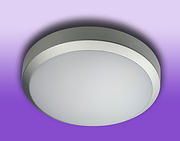Fluorescent is quoted as 20,000 hours and using HF ballast it says lamps last 50% longer so 30,000 hours, although you may find some one who quotes 40,000 hours this is the point where half the lamps have failed so in both cases it could be longer or shorter. After 30 year there is not guarantee either the LED is still made or the fluorescent tube. I know my fat fluorescent tube I used in kitchen in no longer made, however I was still able to replace it with an LED tube.
I bought 16 globe 8W Philips bulbs with a life of 10,000 hours in my living room at 4 hours per night that should have been 4.5 years, however one year down the line and the bulbs had started to fail, and 2 years latter I had just 8 still working and moved to LED bulbs. So one has to expect that 40,000 hours is really 20,000 hours so really looking at a 10 year life.




